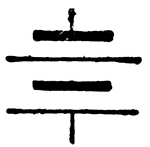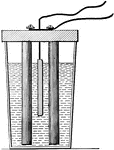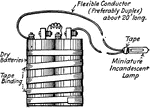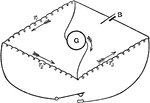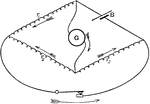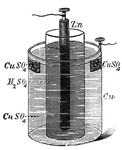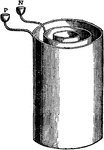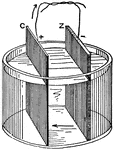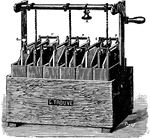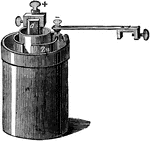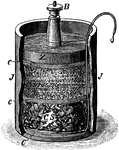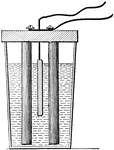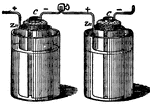Batteries and Cells
This science ClipArt gallery offers 53 illustrations of batteries and cells that are used to produce electric currents and provide power to other tools and devices.

Battery
"The term battery is applied either to a single jar, or cell, containing the generating materials, or…

Battery Resistance
An illustration of the assisting and opposing method used to measure battery resistance.

Galvanic Battery
"Galvanism is the branch of electric science to which an experiment by Galvani gave birth. His wife,…
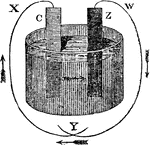
Galvanic Battery
"If we take for example, a slip of zinc, and another of copper, and place the in a cup of diluted sulphuric…

Primary Battery
Battery which is not intended to be recharged and is discarded when it has delivered all of its electrical…
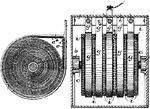
Storage Battery
A rechargeable battery also known as a storage battery is a group of one or more secondary cells. Rechargeable…
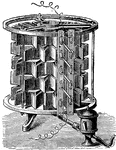
Thermal Battery
An illustration of Clamond's thermal battery; a thermal battery refers to the the electrolyte being…

Trough Battery
The trough battery was a variant of the Voltaic Pile and was invented by William Cruickshank c1800.…
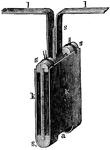
Wallaston's Battery
In Wollaston's battery, the wooden box was replaced with an earthenware vessel, and a copper plate was…

Wallaston's Battery
In Wollaston's battery, the wooden box was replaced with an earthenware vessel, and a copper plate was…

Bennets Electroscope
"The gold leaves are gummed on the two sides of a flat piece of metal carried by a stout stem, which…
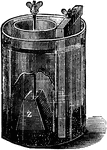
Fuller Bichromate
The cell was set up in a glass, or glazed earthenware, pot. This contained the chromic acid solution,…
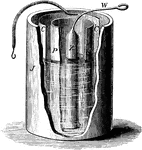
Daniell Cell
The Daniell cell (var. sp. Daniel cell), also called the gravity cell or crowfoot cell was invented…

Grove Cell
An illustration of Bussen's cell.The Grove cell was an early electric primary cell named after its inventor,…

Leclanché Cell
Georges Leclanché invented and patented in 1866 his battery, the Leclanché cell. It contained…

Voltaic cell
"Just as a head of water supplies a hydraulic pressure that causes the liquid to flow through a pipe…
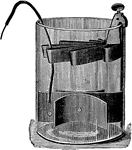
Daniel Cell
"Daniel gravity cell, 'crowfoot' pattern. this is a two fluid cell in which gravity instead of a prous…
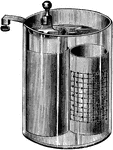
Daniel Cell
The first two-fluid cell was incented by Daniell, and English electrician in 1836..." -Atkinson 1903

Edison Cell
"Edison cell, type RR. The electrolyte used is caustic soda, the positive element zinc, and the negative…

Edison-Lalande Cell
"...is constructed with a plate of black oxide of copper suspended between two plates of zinc, and the…
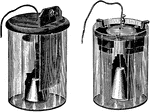
Fuller Cell
"The telephone standard and compound forms of Fuller cell... The Fuller cell is of the double fluid…
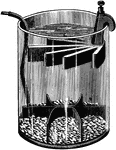
Gravity Cell
"The electric resistance of the porous cup employed in the Daniel cell, and the local action produced…

Grenet Cell
"The elements are zinc and carbon. In the Greet cell, a zinc plate is suspended b a rod between two…

Grenet Cell
"...and is constructed with a zinc plate suspended between two carbon plates, so as to have two carbon…

Grenet Cell
"...and is constructed with a zinc plate suspended between two carbon plates, so as to have two carbon…
!["...or in a number of [leyden] jars connected together as a Leyden battery." -Atkinson 1903](https://etc.usf.edu/clipart/35700/35716/leybatt_35716_mth.gif)
Leyden Battery
"...or in a number of [leyden] jars connected together as a Leyden battery." -Atkinson 1903
Parallel Connection
"Diagram of a multiple or parallel connection. When connected in this manner the voltage of the battery…

Parallel Connection
Figure showing battery cells connected in parallel, with all of the positive ends wired together, and…
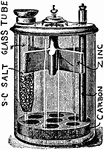
Partz Cell
"Partz acid gravity cell. In this form of cell, the electrolyte which surrounds the zinc is either magnesium…

Series Connection
Figure showing a series type of connection between multiple battery cells, where the negative end of…

Series Multiple Connection
"Diagram of a series multiple connction. Two sets of cells are connected in series, and the two batteries…
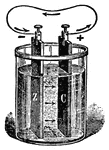
Voltaic Cell
The Voltaic Cell is also known as the Galvanic Battery. Luigi Galvani discovered it. It is a combination…



